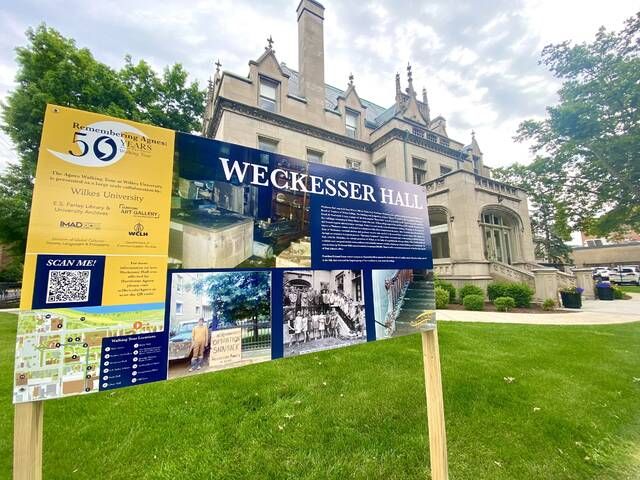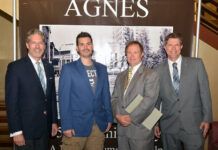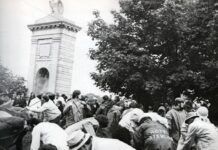
One of the signs set up as part of a self-guided walking tour related to the Agnes Flood and it’s impact on Wilkes University. The school has also set up a website dedicated to the 50th anniversary of the devastating event.
Submitted photo
Click here to subscribe today or Login.
WILKES-BARRE — With a campus that runs right up against the Susquehanna River Levee, Wilkes University suffered substantial damage when the Agnes flood struck in 1972. Recovery costs were in the millions, fortunately offset with a $4 million check President Richard Nixon brought during a campus visit. The high water mark is still visible outside one office in Weckesser Hall.
Despite being directly in the flood plain, Wilkes rebounded with the largest group of new students in its history to that date when it reopened in the fall. It also opened the Sordoni Art Gallery the following year.
These and many other flood-related tidbits have been made available a new interactive website, an audio walking tour and an artifact exhibit. The “Remembering Agnes: 50 Years Later” retrospective is a collaboration of the E.S. Farley Library , the Sordoni Art Gallery, the Wilkes history Department, Integrative Media department and WCLH radio station and web services.
“The walking tour consists of 12 designated stops featuring panels that showcase pre- and post-flood photographs and an opportunity to listen to recordings on some of our building history, narrated by WCLH radio advisor Kristen Rock,” Wilkes archivist Suzanna Calev said in a media release. “The audio tour also includes accounts from Wilkes administrators, faculty, staff and alumni who experienced the flood first-hand.”
You don’t have to take the walking tour to get a lot of the facts, they are posted on a website dedicated to the flood, wilkes.edu/agnes. Some of the most costly damage, perhaps predictably considering its location, occurred at the Dorothy Dickson Darte Center, suffering about $1.75 million in losses, from seating to costumes to two grand pianos. Despite that, the building was repaired enough by December of 1972 to stage “Hello Dolly,” with proceeds benefiting victims of the flood.
The website includes a trove of additional, university-related content, including the Flood Recovery Task Force, Inc., records, 376 Agnes photos, and scrapbooks from Wilkes president at the time, Francis Michellni. The audio tour and exhibits are free and available through the summer.
The self-guided walking tour includes photos, a map and QR code to scan and hear the audio, also available online. The 12 stops are near each other, making the tour flat and relatively easy to take, with many connected by the Fenner Quadrangle at the heart of the campus: Wilkes East Gateway entrance at 141 S. Main St., the nearby Sordoni Art Gallery, Weckesser Hall at 170 S. Franklin Street, the Library at 187 S. Franklin Street, The Stark Learning Center at 150 S. River Street, Chase Hall at 184 S. River Street, Kirby Hall at 202 S. River Street, the Henry Student Center at 84 W. South St., the Dorothy Dickson Darte Center at 239 S. River Street, the President’s house at 33 W. River St., the river itself, across from the Dorothy Dickson Darte Center, and Marts Gym at 292 S. Franklin St.
Reach Mark Guydish at 570-991-6112 or on Twitter @TLMarkGuydish







